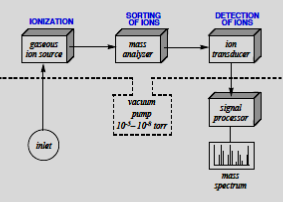Authors: TANMAY HAZRA1 ,MANISH PARMAR1, AKSHAY RAMANI2
1Assistant Professor, Kamdhenu University Gujarat
2M.Tech Scholar, Kamdhenu University Gujarat
Mass spectrometry, is an analytical instrument for detection, identification and quantification of volatile and semi-volatile components and residues; depending on their mass/ charge (m/z) ratio. Generally, a typical Mass Spectrometer consists of three parts: an ion source, a mass analyzer and a detector.
Function of different parts of mass spectrometry -
- Ion Source-to produce ions from the sample.
- Mass Analyzer- to separate ions basis of different mass-to-charge ratios.
- Detector- numbers of different ions are detected according to mass-to-charge ratios.

Fig-1 schematic diagram of a mass spectroscopy
Hard ionization technique vs Soft ionization technique -
The main problem associated with traditional mass spectrometry is that, during analysis of biomolecule the electron use to come contact with the molecule (hard ionization technique) , thus the structure integrity of that molecule use to change and thus create noise error in result. Recently to overcome this problem, soft ionization technique has been adopted where matrix use to cover the biomolecule, so that ions not able to get contact directly with biomolecules.
What is MALDI-TOF-MS or MALDI-MS?
Matrix Assisted Laser Desorption Ionization Time of Flight Mass Spectrometer: soft ionization technique (MALDI), commonly used in mass spectrometry for analysis of peptides, proteins, glycoproeins, oligosaccharides and oligonucleotides etc. MALDI is commonly used in conjunction with time of flight (TOF) mass analyser to achieve higher accuracy and better resolution. It was first described by Karas and Hillenkamp (1988).
Principle of MALDI –TOF-MS-
Principle of MALDI -The sample for analysis is prepared by mixing or coating with solution of an energy-absorbent, organic compound called matrix. When the matrix crystallizes on drying, the sample entrapped within the matrix. The sample within the matrix is ionized in an automated mode with a laser beam. Desorption and ionization with the laser beam generates singly protonated ions from analytes in the sample. The protonated ions are then accelerated at a fixed potential, where these separate from each other on the basis of their mass-to- charge ratio (m/z).
Principle of TOF mass analyser: This mass analyser measures the m/z value of the analyte by pulsing molecular ions from ionization source into a flight/drift tube. m/z values are calculated by time it takes for ions to travel a set distance & strike a detector (i.e. their time of flight).

Fig 2 schematic diagram of MALDI-TOF-MS.
Function of an Ideal MALDI Matrix-
- The matrix seperate the analyte molecule from one another, thereby reducing intramolecular interactions.
- Matrix rapidly absorbs large amount of energy from incoming photons, resulting in an explosive breakdown of matrix-analyte lattice. This explosion sends both matrix & analyte molecule into gas phase.
- 2,5-Dihydroxy benzoic acid
- 2-(4-Hydroxyphenylazo) benzoic acid
- 3,5-Dimethoxy-4-hydroxy cinnamic acid
Advantages of MALDI-TOF MS-
- Soft ionization technique
- Easy sample preparation.
- Highly reproducible results.
- No water or gas hook ups required.
Applications of MALDI-TOF MS milk and dairy product analysis-
- MALDI-TOF MS used analysis milk composition.
- Identification of peptides in cheese or milk protein hydrolysates.
- Profiling of N-glycoproteins in human milk
- Identification of growth factors in milk
- Determination of changes in milk protein profiles due to action of microbes during production
- Identification of adulteration in milk
- Detection of interspecies milk and milk adulteration.
About Author / Additional Info: